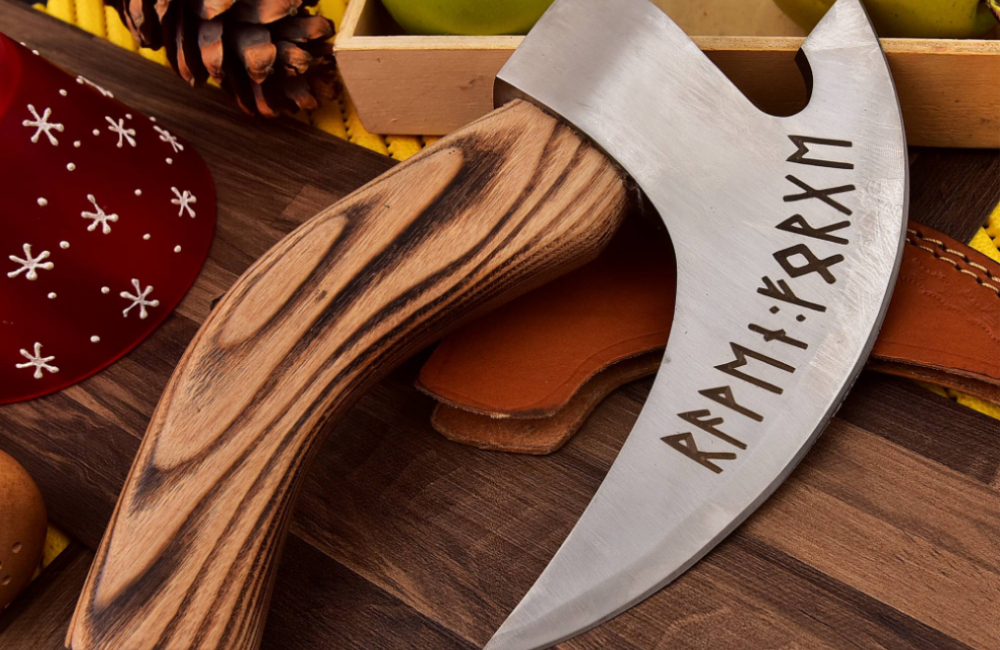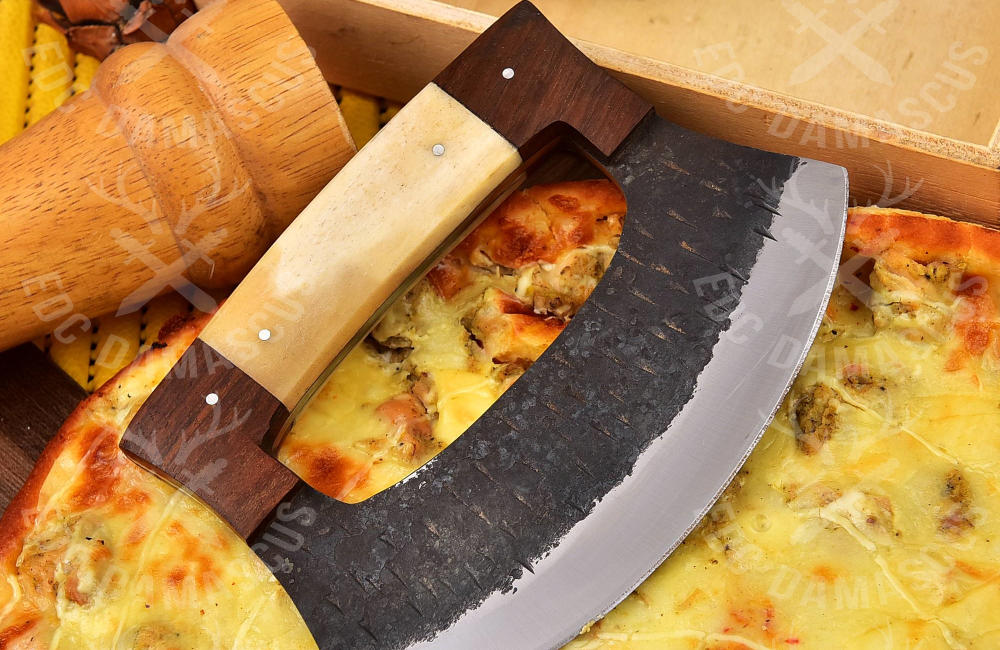When it comes to enjoying a delicious homemade pizza, a sharp pizza cutter is an essential tool for it. Over time, even the highest-quality pizza cutters can lose their edge, making it challenging to achieve clean slices. Luckily, sharpening a pizza cutter is a straightforward process that anyone can master. In this guide, we will walk you through step-by-step instructions on how to sharpen a pizza cutter.
To sharpen a pizza cutter, start by ensuring the blade is clean and dry. Then, use a sharpening stone or a honing rod and hold the blade at a 20-degree angle. After that apply gentle pressure as you run the stone or rod along the edge of the blade. Repeat this process several times on each side of the blade until you achieve a sharp edge. After sharpening, wipe off any metal shavings, clean the cutter, and rinse it. Regular maintenance and sharpening keep your pizza cutter sharp and efficient for slicing.
Shop Quality Pizza Cutter at EDC Damascus
What can you use a pizza cutter for?
The primary design of a pizza cutter is to cut pizzas into individual slices. However, its usefulness extends beyond pizza. Here are some other applications for a pizza cutter:
Cutting Dough:
You can use a pizza cutter to cut dough for various purposes, including making breadsticks, pastries, or homemade pasta.
Slicing Baked Goods:
The pizza cutter comes in handy when slicing through baked goods, such as brownies, bars, cakes, and pies, ensuring clean and precise cuts.
Chopping Herbs:
You can use a pizza cutter as a convenient alternative to a knife. You can use it for chopping herbs like basil, cilantro, or parsley into smaller pieces. It offers ease and efficiency in achieving finely chopped herbs for your culinary creations.
The circular blade of a pizza cutter cuts through vegetables, lasagna, etc., without damaging the blade. Instead, it helps prevent the mess that can occur when using a knife and fork.
Why pizza cutter gets dull?
A pizza cutter becomes dull over time due to friction and repeated contact with hard surfaces. Such as pizza stones or cutting boards. The abrasive nature of these surfaces causes the blade to gradually lose its sharpness.
Additionally, the accumulation of food debris and residues can contribute to the dulling of the blade. As the blade loses its sharp edge, it becomes less effective in slicing through the pizza or other foods. Regular use and lack of maintenance can accelerate the dulling process of a pizza cutter.
Can you sharpen a pizza cutter?
Sharpening and maintaining a pizza cutter can be a bit tricky at first due to its unconventional shape. But it can become easier with practice.
To sharpen the pizza cutter, first hold it at a 45-degree angle. Sharpen the wheel from the inside out for better grip and to prevent spinning out of control. Then, Wet the cutter, apply pressure, and grind it against a stone or a knife to sharpen the edges.
Always follow the instructions provided with the chosen tool to avoid causing any permanent damage. Maintaining a strong grip on the pizza cutter is crucial. Especially considering the initial difficulty in maneuvering the wheel.
Four ways to sharpen a pizza cutter
Sharpening stone:
A sharpening stone is a tool used to sharpen the blade of a pizza cutter. It typically consists of a rectangular or oval-shaped block made of abrasive material. Such as natural or synthetic stones.
To sharpen a pizza cutter using a sharpening stone, hold the cutter at a 20 to 45-degree angle. After that, runs the blade along the stone, applying gentle pressure. This process helps remove any dullness or imperfections on the blade’s edge, restoring its sharpness.
Repeat the motion several times on each side of the blade until the desired sharpness is achieved.
Honing rod:
A honing rod, also known as sharpening steel, is a cylindrical rod typically made of steel or ceramic. It is used to maintain and align the edge of a pizza cutter blade. Rather than removing material to sharpen it like a sharpening stone.
To use a honing rod, hold the pizza cutter at a 20 to 45-degree angle. Then run the blade along the rod, starting from the base to the tip. The honing rod helps realign the microscopic burrs and keeps the blade in optimal cutting condition.
Repeat the process several times on both sides of the blade. Honing the pizza cutter regularly with a honing rod helps to maintain its sharpness and prolong its lifespan.
Knife Sharpener:
A knife sharpener is a tool designed to sharpen the blade of a pizza cutter. There are various types of knife sharpeners available, including manual and electric ones.
Manual sharpeners usually have sharpening slots, such as diamond-coated or ceramic rods. Electric sharpeners feature rotating grinding wheels or belts. To use a knife sharpener, follow the instructions provided by the manufacturer.
Generally, you would pass the blade through the appropriate slots or hold it against the grinding wheel. Knife sharpeners, such store the sharpness of a pizza cutter efficiently and conveniently.
Sandpaper method:
Sharpening a pizza cutter with sandpaper consider the cheapest method. It is an alternative approach to sharpening a pizza cutter when traditional sharpening tools are not available
To use this method, select a piece of fine-grit sandpaper and place it on a flat surface. Hold the pizza cutter at an angle and slide the blade back and forth across the sandpaper. Rotate the cutter as needed to sharpen the entire length of the blade. The abrasive surface of the sandpaper helps remove any dullness or imperfections. Continue the process until the desired level of sharpness is achieved.
How to sharpen a pizza axe?

Sharpening a pizza axe follows a similar process to sharpening a pizza cutter. Here’s a step-by-step guide on how to sharpen a pizza axe:
- Clean the axe: Ensure the axe is clean and free from any food residue or debris. Wipe it down with a damp cloth and allow it to dry completely.
- Secure the axe: Place the pizza axe securely on a stable surface. Such as a workbench or cutting board, with the blade facing up.
- Choose a sharpening tool: Select a sharpening stone or a honing rod suitable for sharpening the edge of the axe blade.
- Angle the blade: Hold the sharpening tool at a consistent angle, typically around 20 to 30 degrees, and position it against the blade.
- Sharpen the blade: Using moderate pressure, move the sharpening tool along the blade in a controlled motion. Begin at the base and work your way towards the tip, maintaining the same angle.
- Alternate sides: Flip the axe and repeat the sharpening process on the other side of the blade. This helps ensure an even and balanced edge.
- Test the sharpness: After sharpening, carefully run your finger along the edge to assess its sharpness. Be cautious to avoid any potential cuts.
- Clean and inspect: Wipe off any metal shavings from the blade, and clean the axe thoroughly. And inspect the sharpness and overall condition of the edge.
Regularly maintaining and sharpening your pizza axe will help maintain its cutting efficiency.
See our collection of quality Pizza Cutter Axe in both Damascus and Carbon Steel.
Can any pizza cutter be sharpened?
Most pizza cutters can sharpen to some extent. Especially with replaceable or high-quality stainless steel blades. However, it’s important to note that not all pizza cutters design with sharpening in mind.
Some low-quality or inexpensive pizza cutters may have blades that are not easily sharpened. These types of pizza cutters are typically disposable and meant to be replaced when the blade becomes dull. If you are unsure whether your pizza cutter can be sharpened, it’s best to refer to the manufacturer’s instructions.
Frequently Asked Questions:
How can you sharpen a pizza cutter?
To sharpen a pizza cutter, you can use a sharpening stone or honing rod. Hold the cutter at an angle, and run the stone or rod along the blade edge, applying gentle pressure for sharpening. Moreover, repeat the process on both sides of the blade until you achieve the desired sharpness. Remember to clean off any metal shavings and properly rinse the pizza cutter after sharpening.
How do you sharpen a pizza cutter without a whetstone?
If you don’t have a whetstone, there are alternative methods to sharpen a pizza cutter. One option is using fine-grit sandpaper. Another option is using a ceramic coffee mug. Hold the cutter at an angle and run the blade along the bottom edge of the mug. And repeat these methods until you achieve the desired sharpness.
How do you sharpen a rotary pizza cutter?
To sharpen a rotary pizza cutter, disassemble the cutter if possible. Hold the blade at an angle, and run the stone or rod along the cutting edge to sharpen the rotary pizza cutter. Further, repeat the process several times on both sides of the blade, and ensure it is clean before using.
Do pizza cutters need to be sharpened?
Yes, pizza cutters can enjoy regular sharpening. Repeated use and contact with hard surfaces can dull the blade of a pizza cutter over time. Sharpening the blade helps restore its sharpness and cutting efficiency. Regular maintenance and sharpening prolong the pizza cutter’s lifespan and optimize its performance.-

